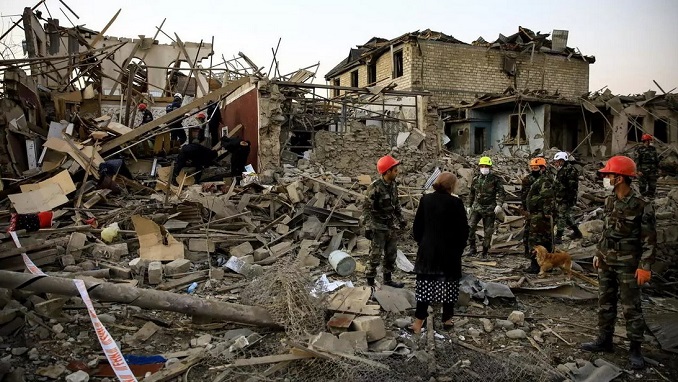Azerbaijan is getting ready to rebuild the recently liberated Nagorno-Karabakh in accordance with modern urbanism, after 30 years of Armenian occupation, The Daily Sabah reported.
Nagorno-Karabakh is entering a new period marked by construction and infrastructure work that will reshape the outlook of the region. Currently, the majority of the liberated lands have the appearance of “ghost towns” as they suffered heavy damage during and after the occupation.
Following the 44-day conflict launched back in September 2020, as Azerbaijan declared a definite victory, Armenian forces left the region after vandalizing the houses and looting everything they could on their way out. Now, it is difficult to have a building in the cities of Nagorno-Karabakh, including Jabrayil, Fuzuli and Lachin, other than piles of stones. Although the symbolic city of the region Shusha was relatively luckier than the others in terms of surviving the vandalism, the religious and cultural monuments in the city still suffered from the aftereffects of the war.
The priority of the Azerbaijani army is to clear the area of mines planted by the Armenian forces and secure the region. So far, since the end of the conflict, 14 Azerbaijanis have lost their lives due to the mines.
Apart from clearing the mines, Azerbaijan also kicked off the efforts to come up with plans and projects for the region while determining the damages and its costs to the region as well. The Azerbaijani government plans to carry the issue to the international courts once it is able to assess the overall damage in the region caused by the Armenian forces.
Relations between the former Soviet republics have been tense since 1991 when the Armenian military occupied Nagorno-Karabakh, a territory recognized as part of Azerbaijan, and seven adjacent regions. Fresh clashes erupted between Armenia and Azerbaijan in late September, rekindling the Caucasus neighbors’ decadeslong conflict over the region. During the conflict, Azerbaijan liberated several towns and nearly 300 settlements and villages from the Armenian occupation. Fierce fighting persisted for six weeks despite efforts by France, Russia and the United States to broker cease-fires, before Armenia and Azerbaijan signed a Moscow-brokered peace deal on Nov. 9. The agreement was signed after Baku’s army overwhelmed separatist forces and threatened to advance on Karabakh’s main city Stepanakert (Khankendi).
One of the main aims of Azerbaijani President Ilham Aliyev is to build new settlements in the region in accordance with modern urbanism while preserving the historical and unique texture at the same time. “Smart city” and “smart village” concepts will constitute the basis of the planned construction, while the rich water resources and sun and wind energy potential of the region will be utilized under the concept of a “green energy” region.
The first project of the region, which is to build a new road from Fuzuli to Shusha, has already started, among others such as laying a foundation for the Fuzuli International Airport.
With these new transportation lines and the rebuilding of the cities, the region is expected to be an attraction center not only for Azerbaijan but also for the entire southern Caucasus region.
